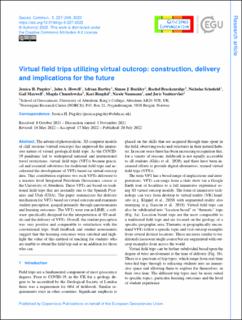| dc.contributor.author | Pugsley, Jessica H. | |
| dc.contributor.author | Howell, John A. | |
| dc.contributor.author | Hartley, Adrian | |
| dc.contributor.author | Buckley, Simon John | |
| dc.contributor.author | Brackenridge, Rachel | |
| dc.contributor.author | Schofield, Nicholas | |
| dc.contributor.author | Maxwell, Gail | |
| dc.contributor.author | Chmielewska, Magda | |
| dc.contributor.author | Ringdal, Kari | |
| dc.contributor.author | Naumann, Nicole | |
| dc.contributor.author | Vanbiervliet, Joris | |
| dc.date.accessioned | 2023-09-15T08:54:04Z | |
| dc.date.available | 2023-09-15T08:54:04Z | |
| dc.date.created | 2022-09-30T12:43:56Z | |
| dc.date.issued | 2022 | |
| dc.identifier.citation | Geoscience Communication. 2022, 5 (3), 227-249. | en_US |
| dc.identifier.issn | 2569-7102 | |
| dc.identifier.uri | https://hdl.handle.net/11250/3089668 | |
| dc.description.abstract | The advent of photorealistic, 3D computer models of cliff sections (virtual outcrops) has improved the immersive nature of virtual geological field trips. As the COVID-19 pandemic led to widespread national and international travel restrictions, virtual field trips (VFTs) became practical and essential substitutes for traditional field trips and accelerated the development of VFTs based on virtual outcrop data. This contribution explores two such VFTs delivered to a masters level Integrated Petroleum Geoscience course at the University of Aberdeen. These VFTs are based on traditional field trips that are normally run to the Spanish Pyrenees and Utah (USA). The paper summarizes the delivery mechanism for VFTs based on virtual outcrops and examines student perception, gauged primarily through questionnaires and learning outcomes. The VFTs were run in LIME, a software specifically designed for the interpretation of 3D models and the delivery of VFTs. Overall, the student perception was very positive and comparable to satisfaction with the conventional trips. Staff feedback and student assessments suggest that the learning outcomes were satisfied and highlight the value of this method of teaching for students who are unable to attend the field trip and as an addition for those who can. | en_US |
| dc.language.iso | eng | en_US |
| dc.rights | Navngivelse 4.0 Internasjonal | * |
| dc.rights.uri | http://creativecommons.org/licenses/by/4.0/deed.no | * |
| dc.subject | 3d modelling | en_US |
| dc.subject | 3d modelling | en_US |
| dc.title | Virtual field trips utilizing virtual outcrop: construction, delivery and implications for the future | en_US |
| dc.title.alternative | Virtual field trips utilizing virtual outcrop: construction, delivery and implications for the future | en_US |
| dc.type | Peer reviewed | en_US |
| dc.type | Journal article | en_US |
| dc.rights.holder | © Author(s) 2022 | en_US |
| dc.description.version | publishedVersion | en_US |
| cristin.ispublished | true | |
| cristin.fulltext | original | |
| cristin.qualitycode | 1 | |
| dc.identifier.doi | 10.5194/gc-5-227-2022 | |
| dc.identifier.cristin | 2057180 | |
| dc.source.journal | Geoscience Communication | en_US |
| dc.source.volume | 5 | en_US |
| dc.source.issue | 3 | en_US |
| dc.source.pagenumber | 227-249 | en_US |
| dc.subject.nsi | VDP::Teknologi: 500 | en_US |
| dc.subject.nsi | VDP::Technology: 500 | en_US |

